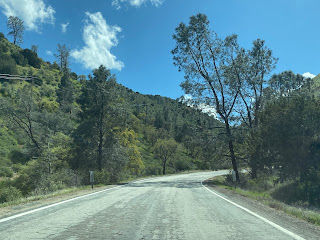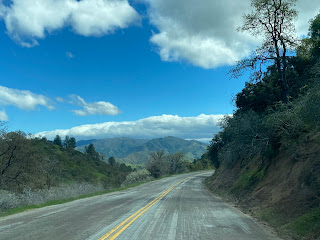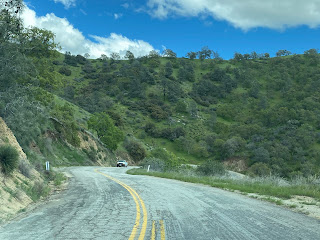Caliente-Bodish Road is one of the finest driving roads in the southern Sierra Nevada range and has rich history. The approximately thirty-two-mile-long highway connects from Kern River Road in Bodfish south to Bena Road (former US Route 466) via Caliente siding. Caliente-Bodfish Road is a segment of Thomas Baker's stage road which facilitated overland travel to the claims of the Kern River Gold Rush. The Baker Stage Road was constructed during the 1860s-1870s and spanned from the outskirts of Caliente north to the Stockton-Los Angeles Road near Tailholt in Tulare County. The blog cover photo is from the nine-mile segment north of Caliente Creek Road which is known as the "Lion's Trail." Caliente-Bodish Road carries the internal designation of Kern County Road 483.
Part 1; the history of Caliente-Bodfish Road
Caliente-Bodish Road is a segment of what was Thomas Baker's stage road to Kern River Valley. The Kern River Gold Rush began in 1853 and spurred development in the southern extent of the Sierra Nevada range.
The Stockton-Los Angeles Road came into use to facilitate travel to the then new Kern River mining claims. The Stockton-Los Angeles Road was a replacement of the earlier route known as El Camino Viejo. Unlike the El Camino Viejo the Stockton-Los Angeles Road avoided the dense Tule Marches in San Joaquin Valley. The Stockton-Los Angles Road stayed close to the Sierra Nevada foothills near the new claims on the Kern River watershed. The corridor of Stockton-Los Angeles Road was also part of the 1858-61 alignment of the southern Butterfield Overland Mail Route.
On April 30, 1855, Buena Vista County was formed by the State Legislature out of what had been the dividing line of Township 20 and Township 21 of Tulare County. The Stockton-Los Angeles Road can be seen on the 1857 Britton & Rey's Map of California heading south from the vicinity of Visalia to the Buena Vista County line via Woodville. The Stockton-Los Angeles Road in Buena Vista County continued south over the Tule River to Stickney's Ferry near Tailholt (displayed as Whites). A trail connecting Tailholt to Linn Valley and the Kern River via Greenhorn Summit is displayed branching from the Stockton-Los Angeles Road.
Buena Vista County was dissolved during 1859 and reabsorbed back into Tulare County. During 1860 a stage road would be created out of the previous trail from Tailholt to the Kern River by way of state funds utilized by Thomas Baker. Thomas Baker's stage road is sometimes referred to in historic record as the "the old Bull Road." The Baker Stage Road continued south from the Kern River towards Tehachapi Pass via Havilah.
Another attempt to split southern Tulare County occurred during 1864 in the form of proposed Coso County. Coso County would have comprised lands which make up present-day Kern County and Inyo County. The proposed Coso County was to be voted upon during 1864 but the election never took place.
Kern County would be formed out of southern Tulare County on April 2, 1866. Kern County comprised the former lands of Tulare County below the Township 24 and Township 25 line. The new Tulare County/Kern County line was located just south of Tailholt and near the Stockton-Los Angeles Road/Baker Stage Road junction. Havilah located on portion of the Baker Stage Road south of the Kern River was selected the original Kern County Seat.
The popularity of the Stockton-Los Angeles Road began to decline rapidly as the Central Pacific Railroad line through San Joaquin Valley was built during the 1870s. Farm diversions for irrigation in San Joaquin Valley and the presence of various rail sidings along the Central Pacific Railroad spurred infrastructure development which made travel through previous wetlands easier.
The 1873 Bancroft's Map of California shows White River (previously Tailholt) located south of the main junction of the Stockton-Los Angeles Road and Baker Stage Road. The primary junction of the Stockton-Los Angeles Road and Baker Stage Road is displayed branching at Fountain Springs. The Baker Stage Road con be seen heading south over Greenhorn Summit towards Kernville, Isabella, Bodfish and Havilah. From Havilah the Baker Stage Road is seen branching through Walker Basin towards Willow Springs via the community of Joe Walker. The Baker Stage Road passed through the future town site of Tehachapi and crossed the Tehachapi Mountains roughly where Tehachapi-Willow Springs Road is now located.
During 1874 Havilah would lose the Kern County seat to Bakersfield. During April 1875 the Southern Pacific Railroad would plot Caliente siding at the site of Allen's Camp. The development of Caliente would have a significant impact on the development of the Baker Stage Road due to it serving as the temporary railroad terminus for sixteen months.
A new spur of the Baker Stage Road south of Rankin Ranch in Walker Basin to Caliente via Oiler Canyon was subsequently constructed. This nine-mile spur contained numerous curves and steep grades which led to it being known as the "Lion's Trail." The Lion's Trail can be seen connecting Caliente and Havilah on the 1882 Bancroft's Map of California. The completion of the Lion's Trail was the final development in what now known is Caliente-Bodfish Road.
The Baker Stage Road can be seen below passing through Havilah in 1910 (courtesy Kern County Museum).
The 1914 United States Geological Survey map of Caliente displays Caliente-Bodfish Road in detail north from the Southern Pacific Railroad to the outskirts of Havilah. The highway is shown to begin in Caliente siding and ascend the Lion's Trail north towards the tolled Bakers Grade Road. Bakers Grade Road branched west towards Bena siding.
Caliente-Bodfish Road north from Bakers Grade Road is shown passing by Rankin Ranch and through Walker Basin towards Havilah.
Caliente-Bodfish Road can be seen as a major local highway connecting Caliente to Vaughan (now part of Bodfish) along the Kern River on the 1917 California State Automobile Association Map.
As part of the 1919 Third State Highway Bond Act Legislative Route Number 57 was extended east from Bakersfield to Freeman Junction via Walker Pass. The newly planned state highway would bypass Caliente-Bodfish Road to the Kern River Valley via the Kern River Canyon east of Bakersfield. The planned Bakersfield-Freeman Junction portion of Legislative Route Number 57 can be seen as a Bond Act Road on the 1920 California Highway Commission Map.
The June 1925 California Highway Bulletin announced the final segment along the Kern River Route of Legislative Route Number 57 was scheduled to be complete during the coming December. The Kern River Route connected Bakersfield directly with Bodfish which negated much of the importance of Caliente-Bodfish Road.
During 1933 the segment of the Baker Stage Road from Isabella to Glennville via Greenhorn Summit was adopted into the State Highway System as part of Legislative Route Number 142. The Kern River Route would become a component of California State Route 178 when the initial run of Sign State Routes was announced during August 1934.
Caliente-Bodish Road can be seen as a major county highway on the 1935 Division of Highways Map of Kern County.
As part of the 1964 State Highway Renumbering the Isabella-Glennville portion of Legislative Route Number 142 was reassigned as California State Route 155. Caliente-Bodfish Road would eventually be assigned as Kern County Road 483.
Part 2; a drive on Caliente-Bodfish Road
Caliente-Bodfish Road southbound begins in Bodfish at the intersection of Lake Isabella Boulevard and Kern River Road (both California State Route 178). Traffic is advised of 14.5 miles of winding roadway ahead. Bodfish was settled in 1867 and is named after George Homer Bodfish. The Post Office service from nearby Vaughn consolidated with Bodfish in 1906. The community is located at approximately 2,687 feet above sea level.
Southbound Caliente-Bodfish Road climbs about Kern River Valley via a series of switchbacks from which Lake Isabella can be viewed.
Caliente-Bodfish Road climbs through an unnamed pass located at approximately 4,000 feet above sea level and begins to descend towards Havilah.
Havilah lies at an elevation of 3,136 feet above sea level. Post Office service operated in the community from 1866 when it was Kern County seat until 1918. Replicas of the 1868 Kern County Courthouse and 1867 Schoolhouse (both constructed in 1966) can be found in the community.
Caliente-Bodfish Road continues south from Havilah and enters Sequoia National Forest. The highway intersects Sequoia National Forest Road 28S07 (Breckenridge Road) which provides access to Breckenridge Mountain.
Caliente-Bodfish Road crests another unnamed pass and descends into Walker Basin. Caliente-Bodfish Road makes a right-hand turn at Walker Road.
Caliente-Bodfish Road continues south through Walker Basin and passes by Rankin Ranch at Walker Basin Road. Rankin Ranch is generally considered to be the beginning of the nine-mile-long Lion's Trail.
Caliente-Bodfish Road reenters Sequoia National Forest south of Rankin Ranch. The highway climbs to a terminal elevation of approximately 4,020 feet above sea level and intersects the now closed Baker Grade Road.
According PjammCycling the final 6.8 miles of the Lion's Trail portion of Caliente Bodfish Road to Caliente Creek Road carries an average grade of 6.9%. The highway descends from 4,020 feet above sea level to 1,552 feet above sea level while passing through numerous curves and switchbacks.
Upon reaching the end of the Lion's Trail the grade of Caliente-Bodfish Road levels and crosses the Union Pacific Railroad (formerly Southern Pacific) upon entering Caliente siding. The Union Pacific Railroad surrounds the community on three sides via an elongated switchback.
Caliente-Bodfish Road departs Caliente and makes a right-hand turn at Bealville Road. Caliente-Bodfish Road continues to a terminus approximately a mile away at Bena Road (former US Route 466).
Version History
- Originally published on June 28, 2018.
- Updated on April 19, 2024








































































































































































Comments